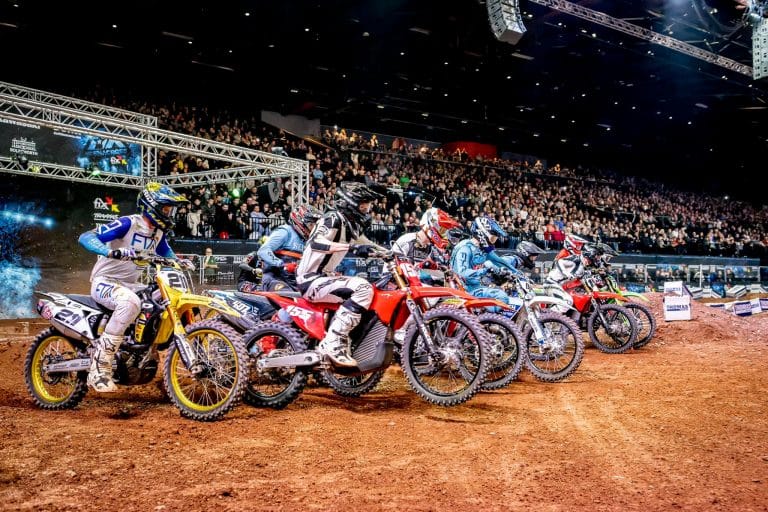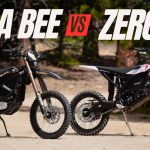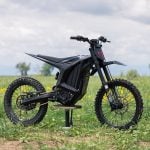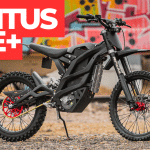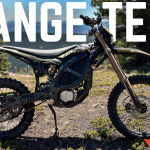It’s a growing question, no doubt about it. As recently as 2023, the rules were vague. If you showed up to your local race with an electric dirt bike, chances were, you’d be allowed to compete with it. But that was mostly due to the bikes’ novelty. Racing organizations simply didn’t know how to classify electric motorcycles, so they just didn’t.
When the Stark Varg began hitting local tracks and trails last year, one thing became very obvious: the bike is fast. Like, really fast. The company’s original claims of being more powerful than any 450cc motocross bike on the market held true. Perhaps thanks to this, the official 2024 racing rulebooks of look quite a bit different than they did a year ago.
In a way, maybe exceeding expectations was a bit of e-proponents electrocuting themselves in their collective foot; the Varg is such a game changer and the established original equipment manufacturers (OEMs) are not quite ready for said game change.
The big dirt bike OEMs (Honda, Kawasaki, Suzuki, Yamaha and the KTM group [KTM, Husqvarna and GasGas]) have not only been the source of the vast majority of off-road motorcycles for decades, they also support the major motorcycle competition sanctioning bodies of the world, namely the Fédération Internationale de Motorcyclisme (FIM) and the American Motorcyclist Association (AMA). As not a single one of the big OEMs has a full-size electric dirt bike on the market at the moment, it should come as no surprise that there is trepidation around allowing a startup company’s new machine to potentially outshine their bikes and technologies that have been developed over the course of decades.

Then there are the unknowns around electric dirt bikes. How and where to classify them? What are the safety protocols? Can they race against internal combustion engine (ICE) machines? How long can they race for? What should the minimum weight requirement be? What should the maximum power output be? What is the standard means of classifying power? For that matter, should the power itself be measured in newtonmeters, kilowatts… horsepower? Do 72 volt systems belong in the same category as 400 volt systems? The questions are seemingly endless.
It’s a brave new world for electric motorcycling and all of these questions will eventually be answered, but at the moment they’re virtually all in a bit of a grey area.
We Rule
Back in the late 1990s, the United States Environmental Protection Agency (EPA) introduced new legislation to pressure motorcycle OEMs to improve the carbon emissions produced by off-road models. Within the finalized ruling of 2002 (called the, take a deep breath… Control of Emissions From Nonroad Large Spark-Ignition Engines, and Recreational Engines [Marine and Land-Based]… whew! Rolls off the tongue), there was a threat: either improve your vehicles’ emissions, or the EPA has the authority to revoke any company’s ability to sell any specific model within the US that was not in compliance. That’s not a minor infraction, it’s a major financial risk. So what was the solution? OEMs were forced to move to an older technology that more or less had to be reinvented: Four-stroke engines.
The more complex engine design burns fuel more efficiently and cleaner than two-stroke engines. At first it was thought that competition four-strokes would never be able to compete with their lighter, and cc-to-cc more powerful, two-stroke counterpart. So the OEMs along with the AMA and FIM had a solution, give the old four-strokes a chance by allowing them to have double the cylinder size. The then 125cc class two-stroke class would allow 250cc four-strokes. The 250cc two-stroke division would go another step further initially, allowing up to 550cc four-strokes to compete.
After a few years of development… surprise, surprise, four-stroke machines won out on power, performance with the unexpected benefit of increased rideability. Within a few years of the reinvented four-stroke race bikes, three of the four Japanese OEMs discontinued two-stroke dirt bikes from their production lines.
Overall, though, most enthusiasts were unaware that the by introducing superior machines that captured consumers’ and racers’ interest, OEMs had effectively averted financial ruin at the hands of the US federal government. Riders were happy with their fast bikes, OEMs were happy with their increased sales, dealers and aftermarket companies were happy with increased business due to the extra parts and complexity of maintaining and modifying four-strokes, and the EPA was happy that their emission standards were being respected. Win, win, win, win, win! Right?
What?
In case you haven’t heard, four-stroke race bikes are loud. I said, FOUR-STROKE RACE BIKES ARE LOUD! So loud, in fact, that AMA Pro Racing had to introduce new decibel limits when four-strokes became the dominant engine style in the pits. So loud that noise is one of the most common reasons cited for permanent track closures. So loud that I have permanent hearing damage from photographing on the floor next to the whoop section at the epic and funky Travis-Pastrana-designed 2009 AMA St. Louis Supercross.
Whether or not you are a racer is irrelevant. All of the technology referenced here is developed around racing or with the intention of racing. In many cases the tech is developed specifically around motocross racing, then adapted to other disciplines.
Why?
So here we are, on the cusp of yet another motor design revolution. But where are the manufacturers stepping up their electric game? Where are the FIM and AMA accommodating for the transition from four-strokes to electrics? They were fine with braap, braap to boom, boom. Why not with boom, boom to zap, zap?
The answer is simple: There is no current EPA pressure to improve recreational off-road vehicle emissions or move to low or zero emissions. Not that we need such pressure, but the truth is, the OEMs do in order to instrument any type of sea change to the industry (not to mention the enormous financial undertaking) as we saw with the four-stroke revolution.
Hopefully, though, such regulation will be superseded by consumer pressure to deliver the most competitive or enjoyable vehicles possible. In this author’s opinion, electric dirt bikes certainly fit the bill.
Where Can I Compete?
Okay, that was a lot of doom and gloom. Here’s some good news: you can still race your electric dirt bike, just not wherever you want to… yet. Here’s where and how you can race.
AMA Motocross
Professional racing is a no go for eMotos for now but that’s a pretty small segment of the market. The good news is that for AMA-sanctioned motocross tracks (which is the banner most MX racetracks run under in the US), the rules allow for each track and AMA referee to make their own determination of whether or not to allow eMotos to compete under their supplemental rules.
Under “Section 2.3 Off-Road Meets, H.5” of the 2024 AMA Racing Rulebook it states:
“a. With the exception of specific E-Classes listed within the AMA Rulebook, electric motorcycle eligibility will be determined through event supplemental rules.
“b. When allowed through event supplemental rules, electric motorcycles will only be eligible to compete in open, non-displacement classes.”
As the prevalence of Varg-level bikes grows, an Electric-Only Class seems like the next logical step.
For those with grand ambitions of racing at the Loretta Lynn’s AMA Amateur National Motocross Championships (guilty), we/you are also out of luck. No full-size eMotos allowed there either at the moment. Only the 50cc-sized Micro-E class allows for KTM/Husky/GasGas electric bikes, along with the new Cobra CX-5E. Same goes for all of the Loretta’s Area and Regional qualifiers.
GNCC
Great news here! The Grand National Cross Country series recently changed its rules to allow for full-size eMotos. They are now allowed to compete in the new Open E amateur class. Rather than the three-hour marathon of the pro classes, the amateur segment is two hours, which at the moment is at the very edge of racing range for any electric dirt bike anyway. Saddle up!
US Sprint Enduro
This Southeastern series was actually the first AMA series to open up to eMotos, offering both Pro Electric and Open Electric classes. This regional championship is growing in popularity, but early races have had very few electric bikes. Is that bad? Hell no! That means, sign up for the pro class and as long as you finish you could very well have a podium in the bag.
Red Bull Tennessee Knockout

The hellish yearly event through Tennessee’s creeks and crags is not only a true test of off-roading skill and prowess, last year it also became the very first AMA event to officially offer an electric-specific class. And (humble-brag here) ECR’s own Tucker Neary played no small role in helping to make that quiet dream a reality. So if you line up at this year’s event on your chosen electron flinger, be sure to throw a little appreciative roost Tucker’s way…if you can keep up. He finished sixth place in 2023.
Non-AMA
J-Day Off Road
The very popular Northeast off-road series is basically sprint hare-scramble/motocross racing at it’s best. Since the championship is also not affiliated with the AMA, they can do as they damn well please, so at the moment there are no specific rules around full-size eMotos. Local legend, Robby Marshall even raced a Stark toward the end of 2023 and did pretty well. The 30-min motos lend themselves very well to most current battery capacities, even at the pro-level.
Additionally, J-Day just partnered with Amped Bikes to offer small-size electric bike racing on the Saturdays before big-bike racing. This means all of you Sur Ron Light Bee and Talaria Sting nuts can get out there and start battling for moto surpremacy… on a perfectly groomed track no less. Zip zap!
Another option that is very similar to J Day is called TORR (Temple Off Road Racing). Run in the Mid-Atlantic region, the entire format and rulebook are very much based off of J Day, so the same rules more or less apply in relation to eMotos.
We’re Going Global
This electrifying (sorry) story is ever changing. Since beginning research on this story, rules have changed multiple times.
United Kingdom

Not only are eMotos permitted to race in the Arenacross British Championship, this past weekend Stark became the very first electric motorcycle company to win a major title… anywhere… ever. With Brit, Jack Brunell at the helm, they captured both the individual and manufacturer championship crowns. All in less than a year since Stark delivered their first production bike to consumers. There might be something to this whole instant torque thing.
Spain
The FIM notoriously backed out of allowing eMotos at the last minute before the first round of the SuperEnduro World Championship in Lievin, France (Stark’s Taddy Blazuziak literally rode press day at the event only to be told that evening that he would not be permitted to race). But that wasn’t the end of the story; enter the Spanish Hard Enduro Championship. The Royal Spanish Motorcycle Federation and the other affiliated governing bodies decided it was in the country’s own best interest (Stark is, for the most-part, a Spanish company) to allow the Varg to compete. To know one’s surprise, Blazuziak did pretty well, placing seventh after a long pitstop in which the entire battery was swapped.
France

Earlier this year, the French Supercross series also welcomed Stark to compete in the SX1 category. With Thomas Do at the helm, the bike performed quite well but there was a catch… the French Federation did not allow any points to be accumulated. Through several rounds, Do would have ranked near the top five, but due to the rule, he is not credited with earning any championship points.
Dakar Rally
Chinese brand, Arctic Leopard is just hitting the market with their full-size 880 E-XE machine. They entered the new bike in the all new Mission 1000 (aimed at specifically developing electric and low- or zero-emission machines) category of the Dakar Rally and were the top placing electric motorcycle brand at this year’s event in Saudi Arabia. You can read all about that in our Dakar Rally coverage from last month.

Australia
Good news from down under: Motorcycling Australia recently updated their 2024 rulebook to include electric motorcycles within all classes of motocross racing. That’s right, as long as your bike is approved, you big bike riders can enter the MX2 class in a 48hp setting or the MX1 class in no more than a 60hp setting. What does this mean? We’re guessing you might see a Varg or two racing in the pro class during the Australian MX Nationals against the four-strokes this season. Call it a hunch.
FIM E-Xplorer
Okay, so the FIM is not allowing eMotos to compete against gas belchers in the established series. But that’s not the end of the story. The FIM E-Xplorer (see what they did there?) World Cup is an electrics-only global series that’s somewhere between MX and endurocross.
2023 was the debut season where riders competed side-by-side, slalom-style. For 2024 they’re using a slightly more traditional gate drop, first-to-the-checkers three-moto racing format. What’s more, Honda HRC just signed on to compete in the full series, fielding two of their beautiful, potent and mysterious CR Electric Protos in the full-size bike class. In fact, Honda already claimed victory in their first go at Round 1 in Osaka, Japan.
The championship is a professional team series, requiring one female and one male rider per team so not just anyone can sign up when a round comes to town. However, they do offer a “Wild Card” entry for anyone willing to take on the gauntlet and substantial (begins at $4876… gulp) entry fee.
Advocate!
If you want to race your eMoto in the US at AMA events, the supplemental rules are your friend. Get in your local AMA representatives ear about wanting to race your machine. Elsewhere in the world, get organized. Work with your local federations, use examples like Motorcycling Australia’s rule change, and let’s go race these electronic two-wheeled gizmos!
This is a developing story and the landscape is ever shifting. Please let us know if you’ve been able to race your eMoto and where.

